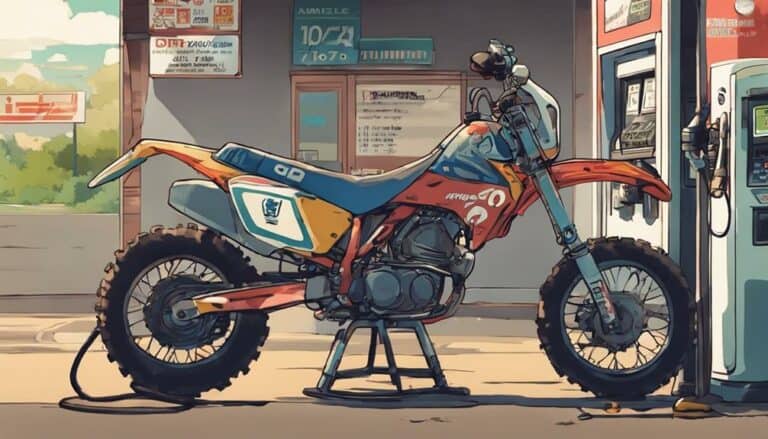When it comes to determining what to put as distance for your dirt bike, think of it like exploring uncharted terrain. The question of how to accurately represent the distance of an off-road machine without a standard odometer can present a unique challenge.
But fear not, as there are practical solutions to this conundrum that can help you stay compliant and informed. Let's explore some insightful approaches to handling dirt bike distance that can benefit both you and your trusty two-wheeled companion.
Key Takeaways
- Use accurate mileage data for maintenance planning and tracking engine runtime.
- Employ hour meters or aftermarket odometers for precise mileage recording.
- Convert hours to mileage for informed maintenance decisions and longevity.
- Ensure clear documentation for registration, title transfers, and bike value maintenance.
Factors Affecting Dirt Bike Mileage
When exploring the factors affecting dirt bike mileage, consider how riding conditions, terrain, and speed preferences directly influence the distance you can cover on your bike. The hour meter on your dirt bike is an essential tool that helps you track the engine's running time accurately. Every hour you put on the bike's motor brings you closer to maintenance intervals, including oil changes, valve adjustments, and other essential services to keep your bike running smoothly.
In varied riding conditions, such as muddy trails or dusty deserts, the hour meter becomes your faithful companion, reminding you when it's time to show your bike some care. The terrain you ride on, whether it's a smooth highway or a rugged mountain trail, can have a significant impact on your bike's mileage, affecting how many hours you clock on the meter. Additionally, your speed preferences play an important role in determining how long your engine runs and how many miles you can squeeze out of your dirt bike.
Keep an eye on that hour meter and adjust your maintenance schedule accordingly for best performance.
Proper Ways to Track Dirt Bike Mileage
Looking to accurately monitor your dirt bike's mileage for best maintenance? Tracking your dirt bike's hours of operation is essential for ensuring peak performance and longevity. By utilizing hour meters, you can precisely monitor the time your bike has been running and schedule maintenance intervals accordingly. Convert these hours into mileage using established formulas to plan maintenance tasks effectively.
For bikes without built-in hour meters, consider installing aftermarket odometers with hour tracking capabilities. This additional tool will provide you with accurate data to make informed decisions about your bike's maintenance needs. Remember that individualized maintenance schedules based on riding conditions are key. Simply relying on mileage isn't always sufficient, as different terrains and riding styles can impact your bike's wear and tear differently.
Understanding Dirt Bike Mileage Calculations
To accurately plan your dirt bike maintenance, understanding how to calculate mileage is key for ensuring peak performance and longevity. Here's a quick guide to help you grasp the concept:
- Calculate Riding Hours: Use the formula Mileage/Average speed = Hours traveled to estimate riding time for maintenance purposes.
- Example Calculation: For instance, covering 300 miles at 22 MPH would translate to roughly 13.6 hours of riding time on your dirt bike.
- Influence of Riding Conditions: Factors like city riding, twisty canyons, or forest service roads can affect your average speed and, consequently, your mileage calculation.
- Important Relationship: Understanding the correlation between mileage and hours is vital for creating precise maintenance schedules tailored to your dirt bike.
Importance of Accurate Mileage Reporting
Accurate mileage reporting on your dirt bike is fundamental for evaluating its wear and tear accurately. Maintaining precise records of your dirt bike's mileage is not just a vital practice; it is a necessity. Incorrect mileage reporting can lead to registration issues, impact the bike's value, and cause complications during transfers. Ensuring that the mileage is accurately documented is essential for evaluating the overall condition of your dirt bike, especially when transferring titles. Clear communication and accurate reporting streamline the title transfer process, saving you time and avoiding potential headaches in the future.
| Importance of Accurate Mileage Reporting |
|---|
| Helps determine wear and tear accurately |
| Prevents registration issues |
| Affects the bike's value positively |
Proper documentation of mileage is key to maintaining a smooth and hassle-free dirt bike ownership experience. By diligently recording the mileage, you not only safeguard your investment but also contribute to a seamless transfer process when the time comes.
Tips for Maintaining Dirt Bike Mileage Logs
Maintain a detailed mileage log for your dirt bike to effectively track its usage and plan maintenance schedules. Keeping accurate records is essential for optimizing your bike's performance and ensuring its longevity.
Here are some tips to help you maintain your dirt bike mileage logs:
- Use a GPS-based odometer or aftermarket odometer with hour tracking features to record mileage precisely.
- When changing your oil, take note of the current mileage and hours on your bike for future reference.
- Utilize conversion formulas to estimate hours based on mileage and average speed, aiding in maintenance planning.
- Customize maintenance intervals based on your riding conditions, terrain types, and average speeds to keep your bike in top shape.
Conclusion
You've learned the ins and outs of what to put as mileage for your dirt bike. By tracking your mileage accurately and maintaining detailed logs, you can guarantee compliance with state laws and avoid any potential issues with registration or title transfers.
Remember, even though your dirt bike may not have a traditional odometer, it's critical to report the most accurate information possible. Keep riding, keep logging, and enjoy the journey ahead!

